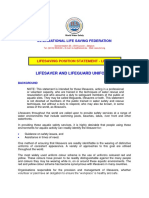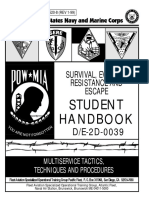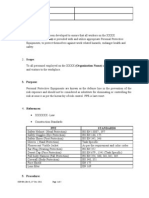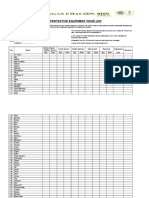Army Board Questions
Army Board Questions
Uploaded by
davidmoralez07Copyright:
Available Formats
Army Board Questions
Army Board Questions
Uploaded by
davidmoralez07Original Title
Copyright
Available Formats
Share this document
Did you find this document useful?
Is this content inappropriate?
Copyright:
Available Formats
Army Board Questions
Army Board Questions
Uploaded by
davidmoralez07Copyright:
Available Formats
Awards and Decorations (AR 600–8–22)
Q. Individual awards are grouped into what categories:
A: a. Decorations.
b. AGCM.
c. Campaign, expeditionary, and service medals.
d. Service ribbons, badges, and tabs.
e. Certificates and letters.
Q. What form is used to recommend awards?
A: DA FORM 638
Q. What is the time limit for recommending an award?
A: Two Years
Uniforms (AR 670-1 and DA PAM 670-1)
Q. One service stripe represents how many years?
A: 3 Years
Q. How far can Sideburns extend?
A: Sideburns will not extend below the bottom of the opening of the ear (see line A of fig 3–1).
Side-burns will not be styled to taper, flair, or come to a point. The length of the individual hairs of
the sideburn will not exceed 1/8 inch when fully extended.
Q. Soldiers will wear headgear with the Army uniform, except under what circumstances:
A:
(1) Headgear is not required if it would interfere with the safe operation of military vehicles.
Wearing military head-gear is not required while in or on a privately owned vehicle (to include a
motorcycle, bicycle, or convertible automobile), a commercial vehicle, or on public conveyance
(such as a subway, train, plane, or bus).
(2) Soldiers will not wear headgear indoors, unless under arms in an official capacity, or when
directed by the commander, such as for indoor ceremonial activities.
(3) Male and female Soldiers are not required to wear headgear to evening social events (after
retreat) when wearing the Army service and dress uniforms or the mess and evening mess
uniforms.
(4) Soldiers will carry their headgear, when it is not worn, in their hands while wearing service,
dress, mess, and evening mess uniforms. Soldiers are authorized storage of the headgear, when
it is not worn, in the Class C uniform cargo pockets, if applicable. Soldiers must fold the headgear
neatly so as not to present a bulky appearance. They may also elect to store it at the small of the
back, with the bill tucked in the belt, provided there is no bulky appearance
Chain of Command
Q. Who is the DCSM?
A: CSM Nash, Adams
Q: Who is the Brigade CSM and the BDE Commander?
A: CSM Etheridge/COL Myers
NCO Duties, Responsibilities and Authority (TC 7-22.7)
Q. Name some basic responsibilities of a NCO?
A: - Maintaining discipline
- Maintaining government property
- Training Soldiers
- Ensuring the welfare of the soldiers
- Executing the mission
Q. As a NCO, you have duties and responsibilities that you must accomplish. What are those duties?
A: 1.Specified
2. Directed
3. Implied duties
Field Sanitation (TC 4-02.3)
Q. What are some Health threats most commonly encountered by U.S. military personnel?
A: Endemic diseases.
Food- and waterborne diseases.
Hazardous plants and animals.
Entomological hazards (nuisance pests and disease-carrying vectors).
Toxic industrial materials (industrial and agricultural).
Deployment-related stress.
Sleep deprivation.
Hazardous noise.
Climatic or environmental extremes (heat, cold, high altitudes).
Q. Regulations state that individual Soldiers are responsible for their own well-being. Each Soldier, as a
minimum, will protect against what?
A: Skin diseases by washing the body as often as practicable.
Heat injury in hot and sunny climates by following work or rest and water consumption
guidelines, by properly adhering to uniform wear policies, and by using sunscreen on
exposed body parts.
Cold injury in cold climates by wearing proper cold-weather clothing and frequently
changing socks to keep feet dry, by careful handling of gasoline-type liquids, and by
avoiding contact between skin and cold metal.
Mosquito, fly, tick, and other arthropod-borne diseases by using insect repellents,
netting, and insecticide aerosols; by taking approved chemoprophylaxis; and by wearing
the uniform properly.
Enteric (gastrointestinal) diseases by using water purification procedures whenever
water quality is uncertain and by avoiding foods prepared by unapproved food vendors,
and by properly disposing of bodily wastes. (Refer to Appendix A for water disinfection
techniques and procedures).
You might also like
- PSSR PDFDocument38 pagesPSSR PDFSELVA GANESH80% (5)
- Fieldcraft BasicDocument58 pagesFieldcraft BasicTheRaypistNo ratings yet
- BS en 00071-2-2011 PDFDocument26 pagesBS en 00071-2-2011 PDFShan Sandaruwan AbeywardeneNo ratings yet
- United States Marine Corps: FMSO 104Document9 pagesUnited States Marine Corps: FMSO 104dan wNo ratings yet
- Expedition ArmoriumDocument8 pagesExpedition ArmoriumLink PelcherNo ratings yet
- Indiana Guard Reserve Uniforms (JFHQ-IGR Regulation 10-4)Document41 pagesIndiana Guard Reserve Uniforms (JFHQ-IGR Regulation 10-4)Herbert Hillary Booker 2ndNo ratings yet
- What Is Functional Clothing?Document5 pagesWhat Is Functional Clothing?Anonymous UoRu4sNo ratings yet
- спикингDocument4 pagesспикингНикита НорченкоNo ratings yet
- RP 0104 - Utility Uniform and Individual Combat EquipmentDocument7 pagesRP 0104 - Utility Uniform and Individual Combat EquipmentDiego Alejandro Tellez ChavezNo ratings yet
- Section 1: 1 October 2007 JFHQ IGR Reg 10 4Document41 pagesSection 1: 1 October 2007 JFHQ IGR Reg 10 4Mark CheneyNo ratings yet
- LE10 -C1L2 _ The Military Uniform and Appearance StandardsDocument3 pagesLE10 -C1L2 _ The Military Uniform and Appearance Standardsedgar.castroNo ratings yet
- TLE M15 Learning Material For Week 4Document4 pagesTLE M15 Learning Material For Week 4Joel Rey CaballeroNo ratings yet
- Unit - 4Document5 pagesUnit - 4محمد محمدNo ratings yet
- Presentation 2Document22 pagesPresentation 2Mohit Jangra007No ratings yet
- Occupational Safety and Health StandardsDocument8 pagesOccupational Safety and Health Standardsjayson casabaNo ratings yet
- SMAWDocument7 pagesSMAWShinNo ratings yet
- International Life Saving Federation: Dress of Competitors - Costumes, Dress and StyleDocument2 pagesInternational Life Saving Federation: Dress of Competitors - Costumes, Dress and StyleManosNo ratings yet
- LE100 CH01 02 p022-041 PDFDocument20 pagesLE100 CH01 02 p022-041 PDFИрина КлочкоNo ratings yet
- Accident and Emergencies Conditons JCH 117Document23 pagesAccident and Emergencies Conditons JCH 117ASHIRUNo ratings yet
- Dragoon Standards Book NewDocument68 pagesDragoon Standards Book NewKolaNo ratings yet
- SOP 08 - Personal Protective EquipmentDocument8 pagesSOP 08 - Personal Protective EquipmenttahaNo ratings yet
- Sub Module 1. PPEDocument20 pagesSub Module 1. PPEMutabazi Igga powersNo ratings yet
- Navy Marine Corps SERE Handbook (1999)Document81 pagesNavy Marine Corps SERE Handbook (1999)Ricardo RodriguesNo ratings yet
- Safety 3 Reviewer For MidtermDocument5 pagesSafety 3 Reviewer For MidtermJimmy C. Enojo Jr.No ratings yet
- Policy 1045 - Uniform Regulations - 201903201536595314Document18 pagesPolicy 1045 - Uniform Regulations - 201903201536595314Ma. Fe Solanche DuqueNo ratings yet
- Lifesaver and Lifeguard Uniforms: International Life Saving FederationDocument3 pagesLifesaver and Lifeguard Uniforms: International Life Saving FederationBuena VellojinNo ratings yet
- Personal Hygiene Basic First AidDocument58 pagesPersonal Hygiene Basic First AidStephen CajeloNo ratings yet
- Military Occupational and Environmental Health: Challenges For The 21st CenturyDocument6 pagesMilitary Occupational and Environmental Health: Challenges For The 21st Centuryh2k69mfNo ratings yet
- Activity 6 MGMT 2Document5 pagesActivity 6 MGMT 2Ramil SalundagaNo ratings yet
- Camilla Nest S61Document13 pagesCamilla Nest S61viboralunaNo ratings yet
- Informasi Cadet NautikaDocument9 pagesInformasi Cadet NautikaIsna HazizaNo ratings yet
- Q1 Las Agricrop9 Week3Document10 pagesQ1 Las Agricrop9 Week3divina violaNo ratings yet
- Inglês 2014 (2º Bimestre Do 2º Semestre)Document9 pagesInglês 2014 (2º Bimestre Do 2º Semestre)Ana Carolina Do Valle100% (1)
- USPHS - Special Uniform SituationsDocument16 pagesUSPHS - Special Uniform SituationsHerbert Hillary Booker 2ndNo ratings yet
- ccr145-2 Chap11 Revised PDFDocument24 pagesccr145-2 Chap11 Revised PDFjamesNo ratings yet
- Ijftr 22 (4) 348-352Document5 pagesIjftr 22 (4) 348-352Lê Ngọc HoanNo ratings yet
- Canadian Scout Manual - BushcraftDocument98 pagesCanadian Scout Manual - Bushcraftg_liou1994100% (1)
- S Ppe Body ProtectionDocument4 pagesS Ppe Body ProtectionJust SleepingNo ratings yet
- SEREDocument97 pagesSEREArthur D Artagnan100% (6)
- Survival Evasion HandbookDocument97 pagesSurvival Evasion Handbookapi-384042895% (19)
- FM 21-15 Care and Use of Individual Clothing and EquiipmentDocument70 pagesFM 21-15 Care and Use of Individual Clothing and EquiipmentLocomiguel100% (4)
- Aviation Survival PT 2 75 PGDocument75 pagesAviation Survival PT 2 75 PGRonLayton100% (1)
- PSSR Hand OutDocument76 pagesPSSR Hand Outvikasjaiswal4213No ratings yet
- 01-Ppe Eng PDFDocument17 pages01-Ppe Eng PDFZaki AdamouNo ratings yet
- The Requirement For PPEDocument40 pagesThe Requirement For PPECtstrphyNo ratings yet
- 5 Lifeguard UniformDocument4 pages5 Lifeguard Uniformabokoraa100% (1)
- BtuDocument39 pagesBtuMel Vin100% (1)
- SO Div B Manual 19-20Document58 pagesSO Div B Manual 19-20Steven OlenchekNo ratings yet
- Risk Management Applied To Food Safety, Security and SanitationDocument3 pagesRisk Management Applied To Food Safety, Security and SanitationLea MaeNo ratings yet
- MD0001 Evacuation in The FieldDocument185 pagesMD0001 Evacuation in The FieldMaria Herciu100% (1)
- Environmental Hazards of Outdoor Recreational Activities: Ten Essential Equipment For MountaineeringDocument2 pagesEnvironmental Hazards of Outdoor Recreational Activities: Ten Essential Equipment For MountaineeringJo KakehNo ratings yet
- jjDocument5 pagesjjmanish kumarNo ratings yet
- Corp ValuesDocument30 pagesCorp ValuesJaroslav JochmanNo ratings yet
- Dugayo Activity 1Document1 pageDugayo Activity 1Ozen YuNo ratings yet
- Occupational SafetyDocument2 pagesOccupational SafetytheedukkespallaceNo ratings yet
- Sop 004 PpeDocument5 pagesSop 004 PpeShahul ValeedNo ratings yet
- Fight Like a Marine - Close Combat Fighting (Official U.S. Marine Handbook): Learn Ground-Fighting Techniques, Takedowns & Throws, Punching Combinations & Kicks; Advanced Weapons Techniques & Defense Against Armed Opponent; Attacking from Side and in Guard…From EverandFight Like a Marine - Close Combat Fighting (Official U.S. Marine Handbook): Learn Ground-Fighting Techniques, Takedowns & Throws, Punching Combinations & Kicks; Advanced Weapons Techniques & Defense Against Armed Opponent; Attacking from Side and in Guard…No ratings yet
- U.S. Air Force Survival Handbook: The Portable and Essential Guide to Staying AliveFrom EverandU.S. Air Force Survival Handbook: The Portable and Essential Guide to Staying AliveNo ratings yet
- Dinosaur Hunter: The Ultimate Guide to the Biggest GameFrom EverandDinosaur Hunter: The Ultimate Guide to the Biggest GameRating: 4 out of 5 stars4/5 (3)
- (1917) Ellsworth, Evelyn Peters - Textiles and Costume DesignDocument126 pages(1917) Ellsworth, Evelyn Peters - Textiles and Costume Designposhta100% (1)
- History of FashionDocument10 pagesHistory of FashionAndrea MontserratNo ratings yet
- Patterning Italian Ren GownsDocument65 pagesPatterning Italian Ren GownsEmma Stern100% (2)
- Helmet CapDocument19 pagesHelmet CapadishicapNo ratings yet
- Il Carnevale © Euroclub SchoolsDocument2 pagesIl Carnevale © Euroclub SchoolsHannahNo ratings yet
- Schiffer German Headgear in World War II - SS NSDAP, Police, Civilian & Misc.Document141 pagesSchiffer German Headgear in World War II - SS NSDAP, Police, Civilian & Misc.Frederic Meth100% (7)
- 16th Century Dance From Khorasan by Lady Vashti Al-AsarDocument20 pages16th Century Dance From Khorasan by Lady Vashti Al-AsarFalconBannerNo ratings yet
- Idiot'S Guide To Militia "Most Commonly Seen"Document7 pagesIdiot'S Guide To Militia "Most Commonly Seen"Marco TulioNo ratings yet
- Hong Kong Standards and Testing Centre: Sample Australia/New Zealand Europe Canada Japan USADocument2 pagesHong Kong Standards and Testing Centre: Sample Australia/New Zealand Europe Canada Japan USAJohn WongNo ratings yet
- Golf Course Dress RegulationsDocument2 pagesGolf Course Dress Regulationsjuniperharru8No ratings yet
- Item Id MtapDocument49 pagesItem Id MtapWaroeng anu tigaNo ratings yet
- Unit 1, More Netiquette: Oncourse - WorksheetDocument1 pageUnit 1, More Netiquette: Oncourse - Worksheetkhawarayub100% (1)
- E-2 Annotation Summary PPCDocument4 pagesE-2 Annotation Summary PPCShaun JohnsonNo ratings yet
- Subanen and Maranao CostumeDocument2 pagesSubanen and Maranao CostumeShim Lei R. Climaco100% (1)
- Shorwell Helmet: DescriptionDocument3 pagesShorwell Helmet: DescriptionJasonNo ratings yet
- Customized Fashion WearDocument6 pagesCustomized Fashion WearMindXX9No ratings yet
- Gothic NewDocument94 pagesGothic NewseensenathuNo ratings yet
- 13 Council of Student Organizations: Minutes of The MeetingDocument3 pages13 Council of Student Organizations: Minutes of The Meetingcso_gmNo ratings yet
- Fallout 4 Armor and Clothing - Fallout Wiki - FandomDocument51 pagesFallout 4 Armor and Clothing - Fallout Wiki - FandomAlejandro Rosales ZambranoNo ratings yet
- Crochet Price ListDocument3 pagesCrochet Price ListKim Morrow0% (1)
- Check List APDDocument2 pagesCheck List APDABDUL KHALIKNo ratings yet
- Item Id MTAPDocument28 pagesItem Id MTAPRedhoKurniawan100% (1)
- Ppe Matrix - SampleDocument36 pagesPpe Matrix - SampleTHANH ĐÔNG DinhNo ratings yet
- The Bronze Italian HelmetDocument468 pagesThe Bronze Italian HelmetbooitsboobNo ratings yet
- 2008-9 Sellstrom Catalog LRDocument56 pages2008-9 Sellstrom Catalog LRAfthab ElatNo ratings yet
- TURBAN The Turban Is Essentially A Headgear That UsesDocument3 pagesTURBAN The Turban Is Essentially A Headgear That UsesLeyla QadooriNo ratings yet
- Example of Comprehension QuestionDocument2 pagesExample of Comprehension QuestionDiwaniNo ratings yet
- Ppe Issue ListDocument9 pagesPpe Issue ListMohd Khairul AnwarNo ratings yet
- Hat ManualDocument9 pagesHat ManualStephen WestNo ratings yet

























































































